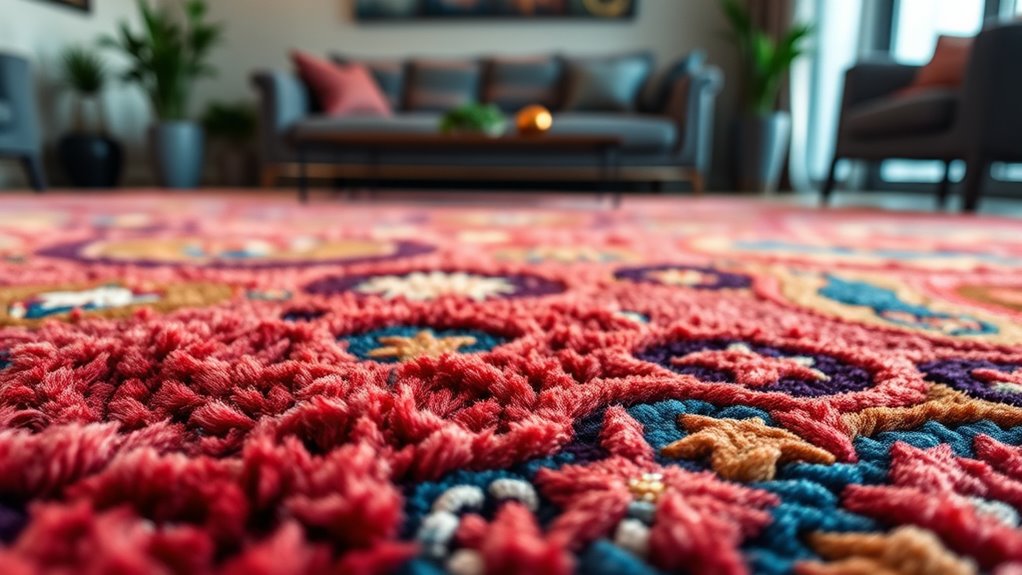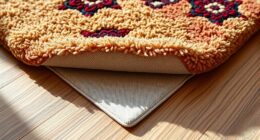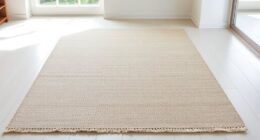Synthetic rugs often release formaldehyde from adhesives, dyes, and backing materials, which can lower your indoor air quality and cause health issues like respiratory irritation, allergies, or skin reactions. To protect yourself, choose natural fiber options like wool or cotton with low-VOC labels, improve ventilation, and air out new rugs before use. If you want to learn more about making your home healthier, keep exploring how to reduce formaldehyde exposure effectively.
Key Takeaways
- Synthetic rugs and backing materials often contain formaldehyde from adhesives, dyes, and resins, contributing to indoor air pollution.
- Formaldehyde off-gassing can cause respiratory irritation, allergies, skin reactions, and fatigue, especially indoors.
- Natural fiber rugs like wool or cotton generally emit less formaldehyde and are safer options for indoor air quality.
- Increasing ventilation, airing out new rugs, and using activated carbon air purifiers can reduce formaldehyde levels indoors.
- Regular cleaning and choosing low-VOC, eco-certified rugs help maintain healthier indoor environments.
Understanding Formaldehyde and Its Sources in Rugs
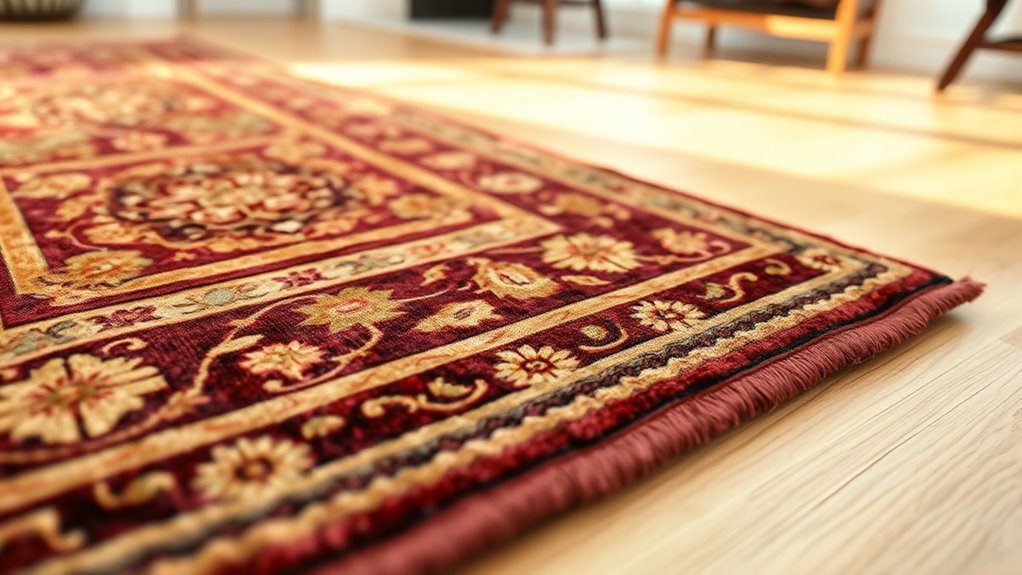
Although rugs can enhance your home’s comfort and style, they may also emit formaldehyde, a harmful chemical found in many indoor environments. Formaldehyde is a colorless, strong-smelling gas used in manufacturing adhesives, resins, and dyes inside rug materials. Many synthetic fibers, such as nylon, polyester, and acrylic, contain formaldehyde-based resins to improve durability and stain resistance. Even some natural fiber rugs, like wool or cotton, can carry residual formaldehyde from processing or treatment. The emission levels vary depending on the rug’s age, manufacturing process, and chemical treatments. Understanding these sources helps you identify which rugs might pose risks. Formaldehyde emissions can fluctuate over time, affecting indoor air quality. Being aware of formaldehyde’s presence enables you to make informed decisions about rug choices to minimize indoor chemical exposure.
How Formaldehyde Affects Indoor Air Quality
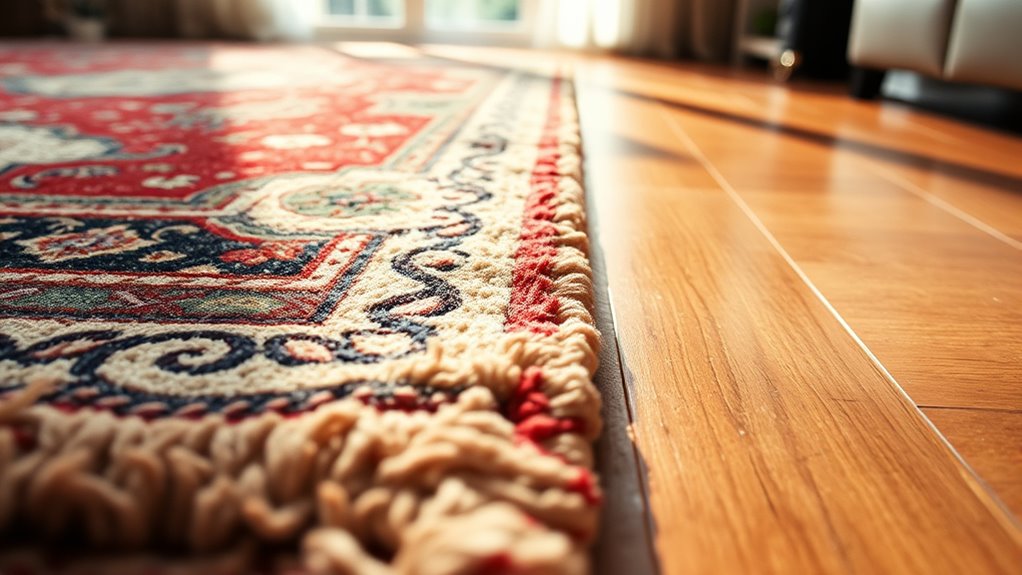
Formaldehyde can considerably impact your indoor air quality by releasing volatile organic compounds (VOCs) into the air you breathe. When formaldehyde off-gases from rugs, it elevates the levels of indoor pollutants, which can linger for days or even weeks. These VOCs can cause your indoor environment to become stale and contaminated, reducing overall air freshness. As you breathe, these chemicals may irritate your respiratory system, trigger allergies, or worsen asthma symptoms. Formaldehyde’s persistent presence can also contribute to a buildup of indoor pollutants, making your indoor air feel heavier and less healthy. The longer formaldehyde remains in your environment, the more your air quality declines, which can affect your comfort, health, and well-being over time. Understanding the effects of VOCs can help you make informed decisions about indoor air quality management.
Recognizing the Symptoms of Formaldehyde Exposure
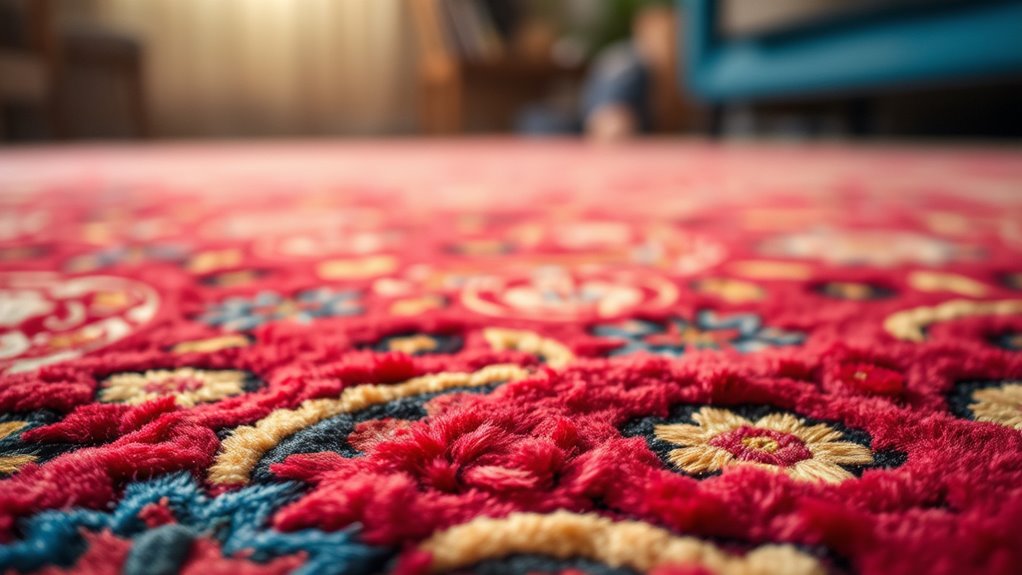
You might notice your lungs feel irritated or your throat becomes sore without an obvious cause. Skin reactions like rashes or itching can also signal formaldehyde exposure. Additionally, persistent fatigue that doesn’t improve with rest could be a warning sign to investigate further. Recognizing indoor air quality issues can help identify sources of formaldehyde in your environment.
Respiratory Irritation Signs
Respiratory irritation is often one of the first signs that formaldehyde may be affecting your indoor air quality. If you notice a persistent cough, sore throat, or a feeling of tightness in your chest, formaldehyde exposure could be a factor. You might also experience frequent sneezing, nasal congestion, or watery eyes. These symptoms tend to worsen when you’re inside and improve when you leave the area. Formaldehyde vapors can inflame your airways, making breathing uncomfortable. If you notice these signs, it’s essential to evaluate your environment, especially if rugs or new furnishings are present. Recognizing these respiratory symptoms early can help you take steps to improve air quality and reduce your exposure. Monitoring air quality can also provide valuable insights into potential pollutant levels in your home.
Skin Reactions Indicators
Skin reactions are another important sign that formaldehyde exposure may be affecting your indoor environment. You might notice redness, itching, or a rash on your skin, especially after spending time in rooms with new rugs or recent furniture. Formaldehyde can cause allergic-like reactions, leading to dermatitis or hives. These symptoms often appear quickly, sometimes within hours of exposure, and can worsen with prolonged contact. If you experience persistent skin irritation or develop unexplained rashes, it’s worth considering formaldehyde as a potential cause. Keep in mind that skin reactions may not occur in everyone, but if they do, it’s a strong indicator that the indoor air quality needs to be checked. Reducing exposure can help alleviate symptoms and improve your overall health. Additionally, indoor air quality can significantly impact respiratory and skin health, highlighting the importance of proper ventilation and source control.
Unusual Fatigue Symptoms
Unusual fatigue is a common but often overlooked sign of formaldehyde exposure indoors. If you find yourself feeling exhausted despite getting enough sleep, it could be linked to airborne formaldehyde from rugs or furniture. This chemical irritates your respiratory system and impairs oxygen flow, leading to persistent tiredness. You might notice that your energy dips during the day or that you feel mentally sluggish. Formaldehyde exposure can also disrupt your sleep quality, compounding fatigue. Pay attention to these symptoms, especially if they improve when you leave your home or ventilate the space. Recognizing this pattern helps you identify potential indoor air quality issues. Addressing formaldehyde sources promptly can restore your energy levels and improve your overall well-being. Additionally, understanding the role of attention in recognizing symptoms can empower you to take proactive steps toward healthier indoor environments.
Identifying Rugs That Are Less Likely to Emit Formaldehyde
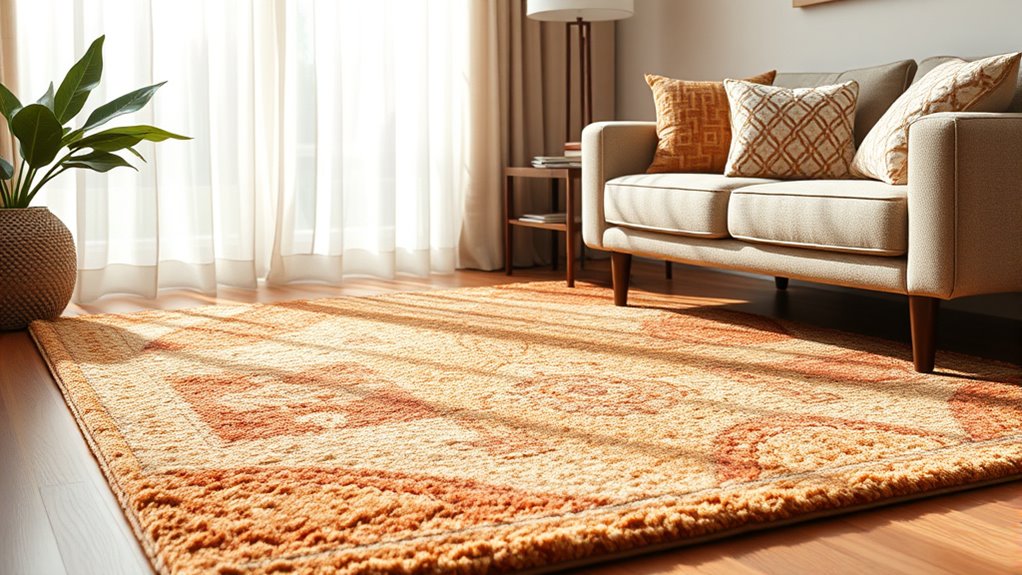
To reduce your exposure to formaldehyde emissions from rugs, it’s important to choose options that are less likely to release these chemicals. Look for rugs made from natural fibers like wool, cotton, or hemp, which typically contain fewer synthetic chemicals. Certifications can also guide you; rugs labeled as eco-friendly or Greenguard Gold certified tend to have lower formaldehyde levels. Additionally, selecting rugs with low-VOC emissions can further improve indoor air quality.
Tips for Reducing Formaldehyde Levels in Your Home
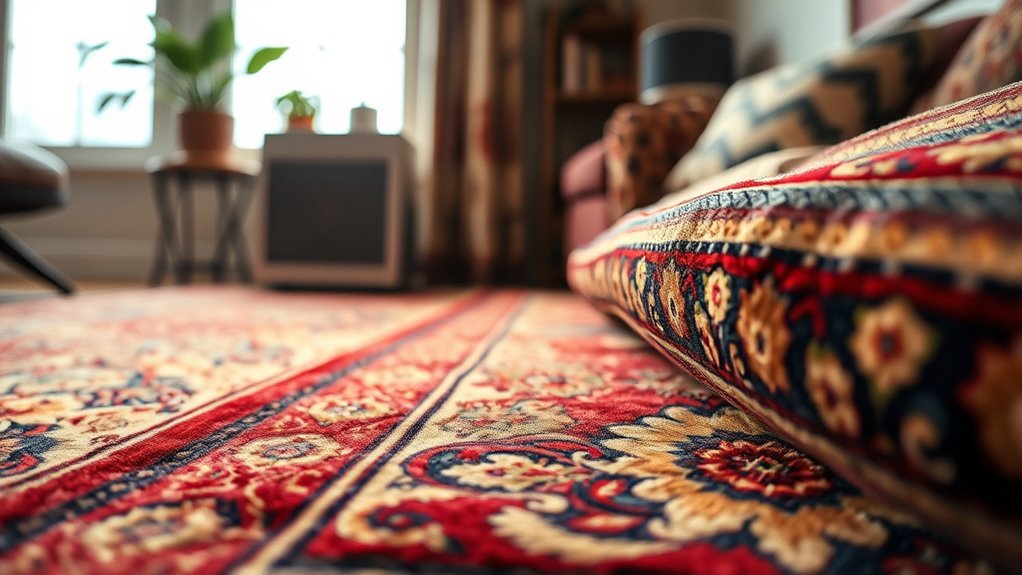
Reducing formaldehyde levels in your home is essential for maintaining healthy indoor air quality, especially since this chemical can off-gas from various household products. To start, increase ventilation by opening windows and using exhaust fans to help disperse indoor pollutants. Regularly air out new furniture, rugs, and other items before bringing them inside. Keep humidity levels low with dehumidifiers or air conditioners, as moisture can increase formaldehyde emissions. Choose natural, low-emitting products whenever possible, and avoid smoking indoors, since tobacco smoke adds to indoor pollutants. Clean your home frequently to remove dust and particles that can trap formaldehyde. Finally, consider investing in air purifiers equipped with activated carbon filters, which can help absorb formaldehyde from the air effectively. Additionally, understanding the emission sources of formaldehyde can help you make more informed choices about household products.
Alternative Flooring and Rug Options for a Healthier Home
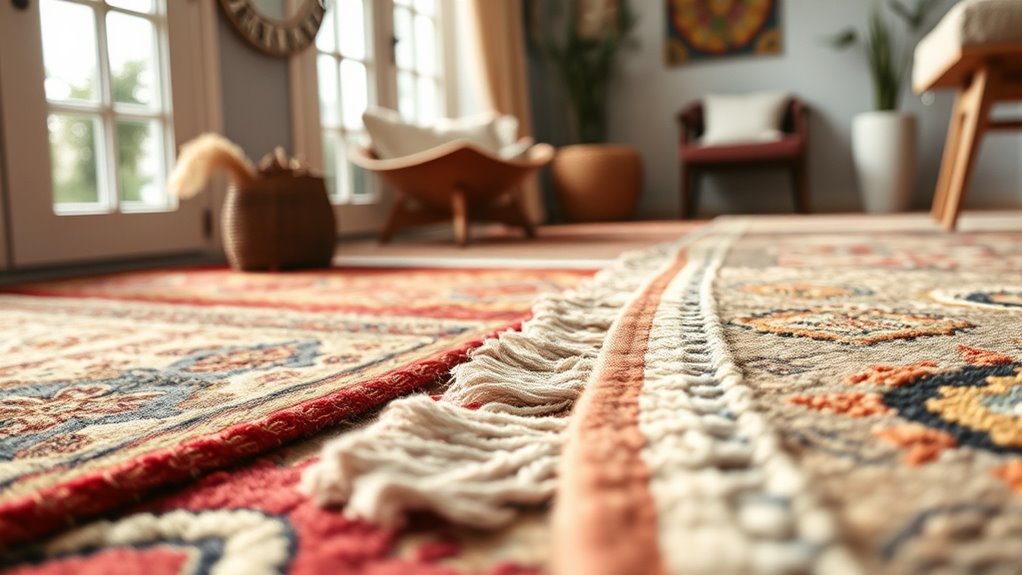
Choosing alternative flooring and rug options can considerably improve your home’s indoor air quality by reducing the presence of chemical emissions. Opt for natural materials like hardwood, bamboo, cork, or linoleum, which typically emit fewer volatile organic compounds (VOCs). For rugs, choose those made from wool, cotton, jute, or hemp, as they’re less likely to off-gas harmful chemicals. Look for products labeled as low-VOC or environmentally friendly to ensure safer indoor air. Avoid synthetic carpets and rugs with synthetic backing or dyes, as they often contain formaldehyde and other irritants. Regular cleaning and proper ventilation also help minimize airborne chemicals. By selecting these healthier options, you create a safer, more breathable environment for you and your family. Natural materials can also add a warm, inviting touch to your farmhouse-inspired decor.
Frequently Asked Questions
How Long Does Formaldehyde Emission From Rugs Typically Last?
You’re wondering how long formaldehyde emissions from rugs last. Typically, these emissions can continue for months or even years after the rug is made, especially if it’s new. However, the highest levels usually occur within the first few weeks. To reduce exposure, air out your rug regularly, use good ventilation, and consider choosing rugs labeled as low-emission or formaldehyde-free. This helps improve your indoor air quality over time.
Are There Specific Rug Materials That Do Not Emit Formaldehyde?
You’re wondering if certain rug materials don’t emit formaldehyde. Natural fibers like wool, cotton, and silk typically don’t contain or release formaldehyde, making them safer choices for indoor air quality. Look for rugs labeled as “low-emission” or “VOC-free,” and always check the manufacturer’s details. By choosing these materials, you minimize your exposure to formaldehyde, creating a healthier environment in your home.
Can Formaldehyde Exposure From Rugs Cause Long-Term Health Issues?
You might wonder if formaldehyde exposure from your rugs could lead to long-term health problems. While short-term exposure can cause irritation and allergic reactions, prolonged exposure may increase risks of respiratory issues or other health concerns, especially if you’re sensitive or exposed in poorly ventilated spaces. To minimize risks, opt for rugs made from natural, formaldehyde-free materials and guarantee good indoor air circulation.
What Are the Safest Certification Labels to Look for in Rugs?
When choosing rugs, look for certifications that verify safety, durability, and eco-friendliness. Opt for labels like Green Label Plus, which guarantees low VOC emissions; OEKO-TEX Standard 100, indicating tested for harmful substances; and Green Guard Gold, ensuring better indoor air quality. These certifications help you identify rugs that are safer for your home, healthier for your family, and better for the environment, giving you peace of mind with every step.
How Often Should Rugs Be Cleaned to Reduce Formaldehyde Levels?
You should clean your rugs regularly, ideally once a week, to help reduce formaldehyde levels. Frequent vacuuming with a HEPA filter can trap dust and airborne chemicals, including formaldehyde particles. For deep cleaning, consider steam cleaning or professional treatments every 6 to 12 months. Maintaining a clean rug environment minimizes chemical buildup, improving indoor air quality and creating a healthier space for you and your family.
Conclusion
By choosing rugs wisely and staying mindful of formaldehyde sources, you can turn your home into a sanctuary of fresh air. Think of your space as a breath of spring, where each step is a dance on a meadow free of hidden toxins. With simple tips and mindful choices, you hold the power to clear the air, transforming your home into a haven where health blossoms like flowers in full bloom.
